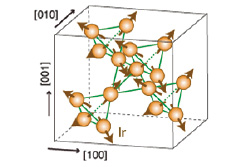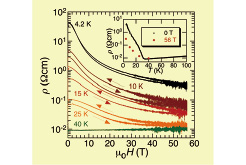Gigantic Negative Magnetoresistance Effects in Pyrochlore Iridates
K. Matsuhira, M. Tokunaga, and M. Wakeshima
Since the discovery of high-Tc superconductivity in cuprate materials, physical properties of 3d transition metal oxides have been extensively studied. In this class of materials, strong Coulomb interaction dominates the other interactions. Various interesting phenomena show up as a result of the interactions between charge carriers and local spins in the orbitals determined by the strong crystal electric fields. On the other hand, 5d transition metal oxides involve strong spin-orbit interaction, and hence, come to attract considerable attention as a playground for novel physics. In particular, rare-earth iridates Ln2Ir2O7 (Ln: lanthanoid elements) are one of the attracting materials because of the geometrical frustration in the pyrochlore structure (Fig. 1).

Fig. 1. Schematic illustration of the Ir-sites in the pyrochlore structure. Corner shared tetrahedra form three-dimensional network of the ions. The brown arrows represent the magnetic moments in the Ir ions.

Fig. 2. Longitudinal magnetoresistance of a high-purity poly-crystal of Nd2Ir2O7 [5]. The observed hysteresis can be caused by the change in temperature due to the magneto-caloric effect. Inset shows temperature dependence of the resistance at 0 T and 56 T.
The series of Ln2Ir2O7 with Ln = Nd, Sm, Eu, Gd, Tb, Dy, and Ho exhibit metal-insulator transition when the Ir spins order at temperatures between 33 K and 141 K [1,2]; the Ir moments exhibit the antiferromagnetic ordering with q=0 (all-in/all-out state) shown in Fig. 1 [3,4]. Thereby, application of sufficiently high magnetic fields to remove the spin order is expected to induce insulator-metal transitions. We studied magnetoresistance on high-purity polycrystals of Nd2Ir2O7 [5] in pulsed high magnetic fields up to 56 T. The results show prominent negative magnetoresistance effects below the metal-insulator transition temperature of 33 K (Fig. 2). The temperature dependence of the resistance at 56 T, however, remains semiconducting as shown in the inset of Fig. 2. This result suggests that the magnetic field of 56 T is insufficient to cause phase transitions in the Ir spin system. Similar behavior is observed when the Ln is magnetic, whereas non-magnetic Eu compound shows positive magnetoresistance effect [5]. Therefore, the observed negative magnetoresistance effects can be caused by the reduction of the spin fluctuation in the rare-earth ions and their coupling to the mobile 5d electrons via the d-f interactions.
References
- [1] K. Mastuhira et al., J. Phys. Soc. Jpn. 76, 043706 (2007).
- [2] K. Mastuhira et al., J. Phys. Soc. Jpn. 80, 094701 (2011).
- [3] K. Tomiyasu et al., J. Phys. Soc. Jpn. 81, 034709 (2012).
- [4] H. Sagayama et al., Phys. Rev. B 87, 100403(R) (2013).
- [5] K. Mastuhira et al., J. Phys. Soc. Jpn. 82, 023706 (2013).
